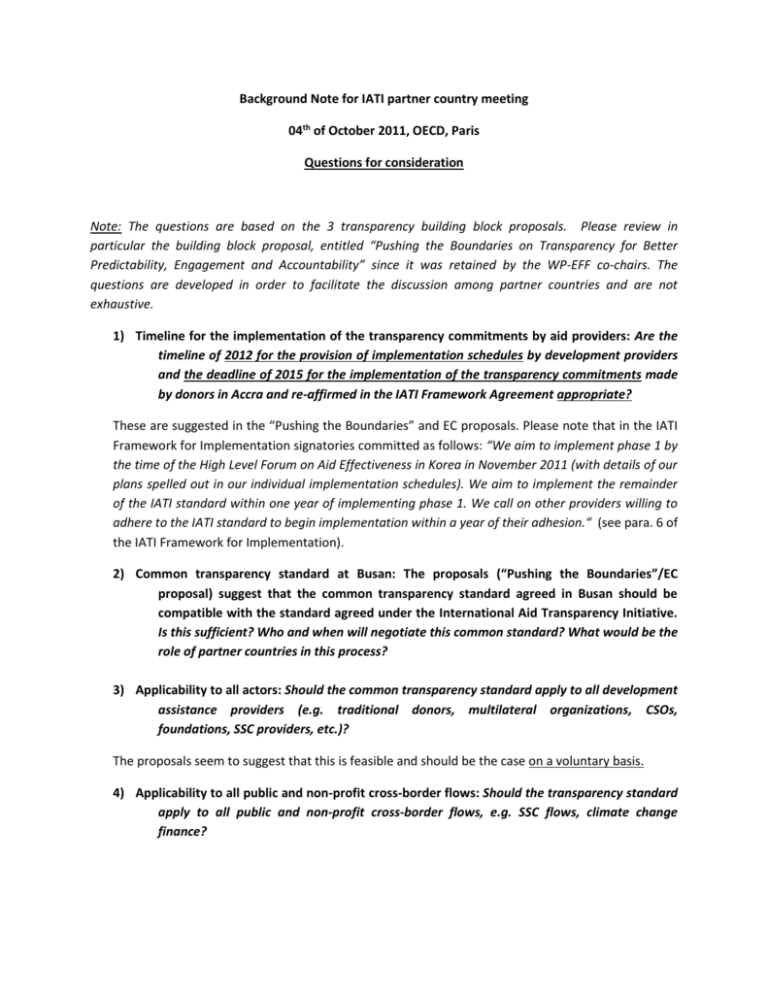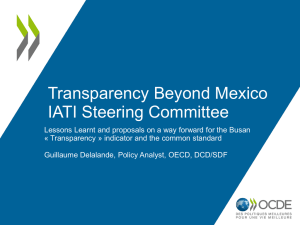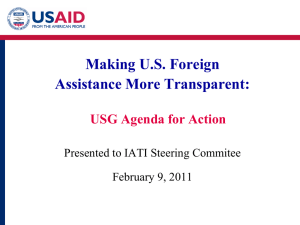Background note for IATI Partner Country Meeting, October 2011
advertisement

Background Note for IATI partner country meeting 04th of October 2011, OECD, Paris Questions for consideration Note: The questions are based on the 3 transparency building block proposals. Please review in particular the building block proposal, entitled “Pushing the Boundaries on Transparency for Better Predictability, Engagement and Accountability” since it was retained by the WP-EFF co-chairs. The questions are developed in order to facilitate the discussion among partner countries and are not exhaustive. 1) Timeline for the implementation of the transparency commitments by aid providers: Are the timeline of 2012 for the provision of implementation schedules by development providers and the deadline of 2015 for the implementation of the transparency commitments made by donors in Accra and re-affirmed in the IATI Framework Agreement appropriate? These are suggested in the “Pushing the Boundaries” and EC proposals. Please note that in the IATI Framework for Implementation signatories committed as follows: “We aim to implement phase 1 by the time of the High Level Forum on Aid Effectiveness in Korea in November 2011 (with details of our plans spelled out in our individual implementation schedules). We aim to implement the remainder of the IATI standard within one year of implementing phase 1. We call on other providers willing to adhere to the IATI standard to begin implementation within a year of their adhesion.“ (see para. 6 of the IATI Framework for Implementation). 2) Common transparency standard at Busan: The proposals (“Pushing the Boundaries”/EC proposal) suggest that the common transparency standard agreed in Busan should be compatible with the standard agreed under the International Aid Transparency Initiative. Is this sufficient? Who and when will negotiate this common standard? What would be the role of partner countries in this process? 3) Applicability to all actors: Should the common transparency standard apply to all development assistance providers (e.g. traditional donors, multilateral organizations, CSOs, foundations, SSC providers, etc.)? The proposals seem to suggest that this is feasible and should be the case on a voluntary basis. 4) Applicability to all public and non-profit cross-border flows: Should the transparency standard apply to all public and non-profit cross-border flows, e.g. SSC flows, climate change finance? 5) Aid & fiscal transparency: Should the post-Busan transparency agenda comprise aid transparency and fiscal transparency? How will the partners ensure that the implementation of the aid transparency commitments remains a priority? The “Pushing the Boundaries” proposal suggests the creation of a global partnership comprising aid and fiscal transparency efforts. IATI has done some work on the “recipient country budget identifier”, which will allow better mapping of aid information to national budget classifications and is pursuing further work in 2011/2012 as part of the IATI country pilots in the DR Congo and Rwanda and additional research. The partner country position papers in relation to the 4th High-Level Forum all underscore the importance of delivering the “unfinished aid effectiveness agenda”. As recognized in the Progress Since Paris report and other evidence, progress on transparency has been made, but a lot remains to be done for this to be a sustainable trend. 6) Future hosting of the common transparency standard: Where should the transparency standard be hosted in the future? The EC proposal calls for “the DAC to be transformed into an international hub for transparency, including hosting of the standard”, while the “Pushing the Boundaries” one proposes the establishment of a Global Transparency Task Force “to serve as an umbrella group” that does not replace the existing initiatives, but rather coordinates their efforts. The IATI proposal does not address the issue of hosting, since the agreed way forward within IATI is to have a consultation process among the key stakeholder groups in the next months. 7) Capacity development of users: What is the place of capacity development of users in the transparency agenda? The “Pushing the Boundaries” proposal addresses this issue in its section on fiscal transparency (see last bullet point on page 3). Capacity development is a priority in all the position papers prepared by partner countries. More specifically the partner country position paper issued in June reads (para. 12): “…Serving these objectives more fully requires more efforts to focus on establishing transparent aid management information systems which would capture all aid flows whether from official or private sources, and build capacity in our countries as well as in our DPs to make better use of information in operational and policy decisions and in monitoring the implementation of agreed commitments. This must also be viewed as a joint responsibility, with our countries and DPs contributing information on aid policies, aid volumes, disbursements, conditionalities and results, and doing so within agreed time frames.” Capacity development also features in the work of the Task Team on South-South Cooperation in relation to capacities of countries to manage SSC flows, including the requisite information systems.






